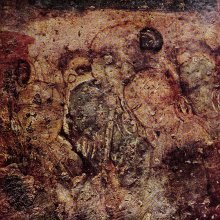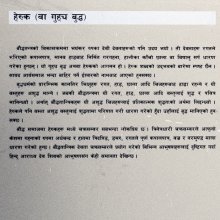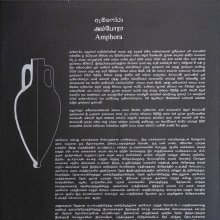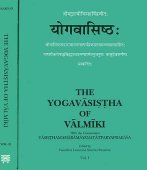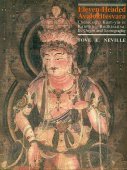Similarity: 2 definitions
Introduction:
Similarity means something in Hinduism, Sanskrit. If you want to know the exact meaning, history, etymology or English translation of this term then check out the descriptions on this page. Add your comment or reference to a book if you want to contribute to this summary article.
Images (photo gallery)
In Hinduism
Shilpashastra (iconography)
Source: Shodhganga: Elements of Art and Architecture in the Trtiyakhanda of the Visnudharmottarapurana (shilpa)Similarity (in a painting) is denoted by the Sanskrit term Sādṛśya, which represents one of the six limbs of Painting (citra), according to the Kāmasūtra and Viṣṇudharmottarapurāṇa, an ancient Sanskrit text which (being encyclopedic in nature) deals with a variety of cultural topics such as arts, architecture, music, grammar and astronomy.—The fifth limb of Painting called sādṛśya denotes similarity. The Viṣṇudharmottarapurāṇa speaks about five types of eyes that bear similarities with the forms of fish, conch, lotus petals etc. which will be discussed in due course.

Shilpashastra (शिल्पशास्त्र, śilpaśāstra) represents the ancient Indian science (shastra) of creative arts (shilpa) such as sculpture, iconography and painting. Closely related to Vastushastra (architecture), they often share the same literature.
Ayurveda (science of life)
Source: ORA: Amanaska (king of all yogas): (ayurveda)Similarity (of origin) is denoted by the Sanskrit term Sādharmya, according to the Kāśyapasaṃhitā (Khilasthāna, verse 9.43-45ab) in a chapter on abdominal swelling caused by vitiation of the blood.—Accordingly, “Listen to the cause of that which produces the cravings [of a seemingly pregnant woman with raktagulma]. Generally, there is desire for those tastes which cause an increase of the bodily constituents because of the true similarity of their origin (yoni-sādharmya). [When] the vitiated blood has a Vāta or Pitta [imbalance] and is accumulating, it fuels desire for tastes such as [those which are] acrid, sour, salty and so on”.

Āyurveda (आयुर्वेद, ayurveda) is a branch of Indian science dealing with medicine, herbalism, taxology, anatomy, surgery, alchemy and related topics. Traditional practice of Āyurveda in ancient India dates back to at least the first millenium BC. Literature is commonly written in Sanskrit using various poetic metres.
See also (Relevant definitions)
Full-text (+474): Sadrishya, Anukarana, Sarupya, Shamya, Sayujya, Pratimatamtra, Pratimana, Vishuddhi, Sadrisha, Upamana, Satiganu, Polveveru, Samambade, Upama, Taulanikate, Sarupata, Sadisatta, Sadharmatva, Sadharmya, Tulyata.
Relevant text
Search found 236 books and stories containing Similarity; (plurals include: Similarities). You can also click to the full overview containing English textual excerpts. Below are direct links for the most relevant articles:
Shishupala-vadha (Study) (by Shila Chakraborty)
The influence of Kālidāsa, Bhāravi and Bhaṭṭi on the Śiśupālavadha < [Introduction]
Novelty of the epic Śiśupālavadha < [Introduction]
Rāmāyaṇa, Mahābhārata and Purāṇas in the Śiśupālavadha < [Introduction]
Mandukya Upanishad (Madhva commentary) (by Srisa Chandra Vasu)
Karika verse 3.9 < [Chapter 3 - Third Khanda]
Karika verse 3.5 < [Chapter 3 - Third Khanda]
Karika verse 3.7 < [Chapter 3 - Third Khanda]
Padarthadharmasamgraha and Nyayakandali (by Ganganatha Jha)
Text 1: Purpose of the Science < [Chapter 1 - Introduction]
Text 94 < [Chapter 6a - On Qualities]
Text 7 < [Text 2: Source of Knowledge]
Kashyapa Shilpa-shastra (study) (by K. Vidyuta)
4. Conclusion (Āgamas and Kāśyapa Śilpaśāstra) < [Chapter 6 - Conclusion]
Conclusion < [Chapter 2 - Author and his Works]
6. Scope and Focus (of the Present Study) and Conclusion < [Chapter 1 - Introduction]
Lord Jhulelal: An Analytical Study (by Thakkar Harish Gopalji)
Part 22 - Varuna and Ahura Mazda and Amesha Spentas < [Chapter 4 - Analysis]
Part 28 - Literature Review: Zarathushtra by Kety K. Dady Burjor < [Chapter 2 - Literature Review]
Part 19 - Similarities between Vedic deity Varuna and Lord Jhulelal < [Chapter 4 - Analysis]
Puppetry in Assam (by Gitali Saikia)
Related products
